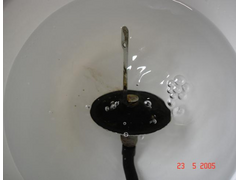
Rover V8 vac advance unit?
Moorron - 28/11/08 at 02:21 PM
Quick and embarrassing question but I need to find out.
Range rover classic with 3.9 (4.6 stroker) petrol EFI hotwire V8 manual. I was checking it over the other day after idle problems which I got some
help off here on and after clearing all the inlet and parts up I solved my original problem, but I have noticed the vac advance unit on the dizzy has
broke, I can suck on the pipe to it and I donít get any resistance. First thing is: what exactly does this do, am I risking damage to the engine with
it broke?
Other thing is why would it break after less than 12 months of use from replacing it with a genuine original part this time last year? I seem to get
resistance if I blow into it but nothing when I suck it. Maybe I am doing it wrong and need the girlfriends help? Lol
Thanks
Andy
r1_pete - 28/11/08 at 02:29 PM
It advances and retards the ignition depending on engine load, it uses the Manifold Absolute Pressure MAP, against a diaphragm to move the distributor
base plate. More vacuum more advance, boot the car, the manifold pressure drops, the ignition retards to prevent detonation and deliver the spark a
bit later so the burn is just established at tdc not before.
They rarely give trouble I've only ever replaced one in 30 years driving and that was on a 200K mile Cavalier.
Damage, probably, it will be effecting the mixture, extra air if there is no resistance, timing will be retarded, fuel consumption up, performance
down.
[Edited on 28/11/08 by r1_pete]
02GF74 - 28/11/08 at 02:49 PM
I had one of these go on my V8 and looked into getting replacement.
There are different flavours, mine being P6 dizzy meant it was the most expensive but reading about them, the Range Rover ones had means to both
advance and retard - I recall there was two thin pipe going to them.
I tried to repair one, managed to get the pressed on cover off and using a disc made from inner tube almost cracked it but it still leaked thus ended
up paying £ 60 for a new one.
Look at Paddocks and Craddocks website - they do LR/RR spares but you need to know part number or model/year.
Anyways what they do. It really is for ecomony (and emissions?) as they advance ignition at high vacuum i.e. at idle.
The way you are tesing is correct, you should suck the tube and then have it hang off your tongue.  Alternative is to put the unit in water and
blow in the tube - as below.
Alternative is to put the unit in water and
blow in the tube - as below.
I heard that petrol damages the diaphragm so you are supposed to position the vacuum pipe in such a way to prevent this - I seem to recall some had
vapour traps.


Rescued attachment va.JPG
britishtrident - 28/11/08 at 03:00 PM
The vac advance is essentially an economy device it gives extra advance under part and light throttle conditions which allows the mixture to be
leaned off under cruise conditions. It dosen't affect full throttle conditions much but will affect fuel ecomomy and response to small changes
in throttle under cruise conditions. It could also cause the engine to run lean under light throttle.
The vac advance on manifold gauge pressure.(ie manifold pressure relative to ambient atmospheric) The spring link detaching from the
diaphragm was a very failure on cars with Lucas distributors.
****First thing to check is that the moving part of the distributer base plate is not floating around due to the spring link being detached. as this
woill cause the ignition timing to float around****
Moorron - 28/11/08 at 03:36 PM
I remember it being costly (£60+) and really dont want to keep on replacing it every year if something else is making it break.
Just reading on the net and it does say that the plate does tend to seize or wobble about. Looks like i am investigating it tomorrow then. Its not
easy with the water pipe above it *sigh*
Lol my fuel consumption is poop anyway at 15mpg.
Paul (Notts) - 28/11/08 at 04:39 PM
Their should be a small device ( cant remember what its called in the tube that goes form the engine to the dizzy. It stops petrol fumes from ending
up in the dizzy as these dissolve the vac advance unit quite quickly.
Paul
 Alternative is to put the unit in water and
blow in the tube - as below.
Alternative is to put the unit in water and
blow in the tube - as below. 